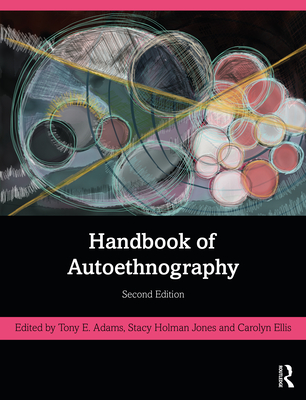Handbook of Autoethnography

Handbook of Autoethnography
The second edition is organized into five sections: In Section 1, Doing Autoethnography, contributors explore definitions of autoethnography, identify and demonstrate key features of autoethnography, and engage philosophical, relational, cultural, and ethical foundations of autoethnographic practice.
In Section 2, Representing Autoethnography, contributors discuss forms and techniques for the process and craft of creating autoethnographic projects, using various media in/as autoethnography, and marking and making visible particular identities, knowledges, and voices.
In Section 3, Teaching, Evaluating, and Publishing Autoethnography, contributors focus on supporting and supervising autoethnographic projects. They also offer perspectives on publishing and evaluating autoethnography.
In Section 4, Challenges and Futures of Autoethnography, contributors consider contemporary challenges for autoethnography, including understanding autoethnography as a feminist, posthumanist, and decolonialist practice, as well as a method for studying texts, translations, and traumas.
The volume concludes with Section 5, Autoethnographic Exemplars, a collection of sixteen classic and contemporary texts that can serve as models of autoethnographic scholarship.
With contributions from more than 50 authors representing more than a dozen disciplines and writing from various locations around the world, the handbook develops, refines, and expands autoethnographic inquiry and qualitative research. This text will be a primary resource for novice and advanced researchers alike in a wide range of social science disciplines.
PRP: 595.10 Lei
Acesta este Pretul Recomandat de Producator. Pretul de vanzare al produsului este afisat mai jos.
535.59Lei
535.59Lei
595.10 LeiLivrare in 2-4 saptamani
Descrierea produsului
The second edition is organized into five sections: In Section 1, Doing Autoethnography, contributors explore definitions of autoethnography, identify and demonstrate key features of autoethnography, and engage philosophical, relational, cultural, and ethical foundations of autoethnographic practice.
In Section 2, Representing Autoethnography, contributors discuss forms and techniques for the process and craft of creating autoethnographic projects, using various media in/as autoethnography, and marking and making visible particular identities, knowledges, and voices.
In Section 3, Teaching, Evaluating, and Publishing Autoethnography, contributors focus on supporting and supervising autoethnographic projects. They also offer perspectives on publishing and evaluating autoethnography.
In Section 4, Challenges and Futures of Autoethnography, contributors consider contemporary challenges for autoethnography, including understanding autoethnography as a feminist, posthumanist, and decolonialist practice, as well as a method for studying texts, translations, and traumas.
The volume concludes with Section 5, Autoethnographic Exemplars, a collection of sixteen classic and contemporary texts that can serve as models of autoethnographic scholarship.
With contributions from more than 50 authors representing more than a dozen disciplines and writing from various locations around the world, the handbook develops, refines, and expands autoethnographic inquiry and qualitative research. This text will be a primary resource for novice and advanced researchers alike in a wide range of social science disciplines.
Detaliile produsului









